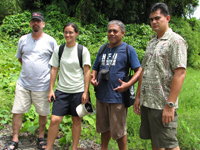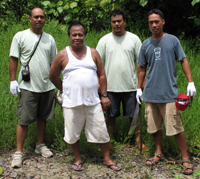FIND OUT WHO OUR BATTLERS OF THE YEAR ARE HERE!!!
PILN Teams are either the national invasive species committee or a sub-group of a national committee. These teams are multi-agency and multi-sector and are usually led by one or two government agencies, with support from the others. The structure of PILN Teams depends on how it best operates at the local level, and some teams may have chairs, others a coordinator, or both.
 |
 |
 |
 |
 |
|
 |
 |
|
 |
||
| |
|
Ideally, PILN Teams will have some recognition at the government level as an advisory body on invasive species issues. These Teams play an important role in discussions of invasive species issues at the national, regional and international levels.
Representatives from multi-agency teams (including government and non-government representatives) dealing with invasive species issues come together to help create and use the network to share skills and knowledge in invasive species management with their colleagues in the region. The Network provides support for representatives from participating teams to meet together in periodic network meetings, to engage in learning exchanges and to link with experts from around the world.
PILN is serving Pacific island teams representing the array of agencies responsible for Invasive Species management in a country, state, province, territory or island. Typically, established invasive species groups or committees nominate 3 to 5 representatives for PILN membership who then bring back the lessons learned through PILN. Alternatively, a multi-agency group of 3 to 5 members is formed specifically to participate in PILN. The network launch took place at the end of May 2006 in Palau, and three additional meetings have since been held, including one in Moorea, French Polynesia, at PILN meeting 2007, on Kiritimati Island, Kiribati from 22–27 March 2012, and most recently in Saleapaga, Samoa, from 1–5 August 2016.
There are currently 24 participating teams:
- American Samoa
- Commonwealth of Northern Marianas
- Fiji
- French Polynesia
- Guam
- Hawai‘i
- Kiribati
- Kiritimati, Line Islands
- Gilbert Islands
- Kosrae State, Federated States of Micronesia
- Marshall Islands
- New Caledonia
- Niue
- Palau
- Pohnpei State, Federated States of Micronesia
- Republic of the Marshall Islands
- Samoa
- Solomon Islands
- Tokelau
- Tonga
- Tuvalu
- Vanuatu
- Wallis & Futuna
- Yap State, Federated States of Micronesia
Participating teams identify strategic and field level Projects which they require network support to advance.
 |
 |
 |
|
Pouono and Tualagi stripping bark to kill the invasive weed tamaligi, Falcataria moluccana, on Tutuila Island, American Samoa. Photo credit: © NPS Tavita Togia
|
Mark, Natasha, Billy and Joseph of the Samoa team.
Photo credit: © NPS Tavita Togia
|
John, Jackson, Donald and Roseo of the Pohnpei team.
Photo credit: © Jill Key
|